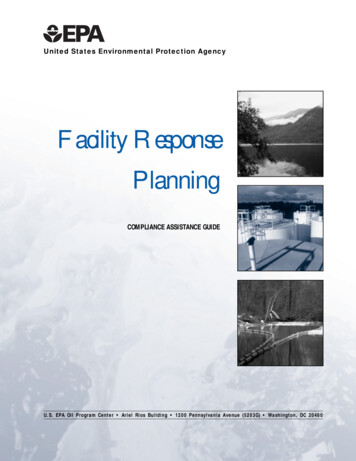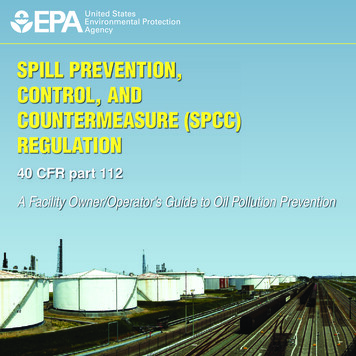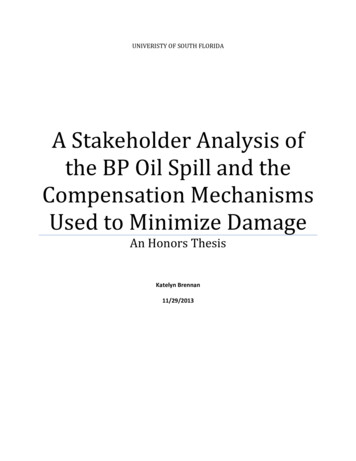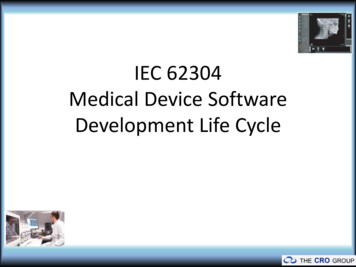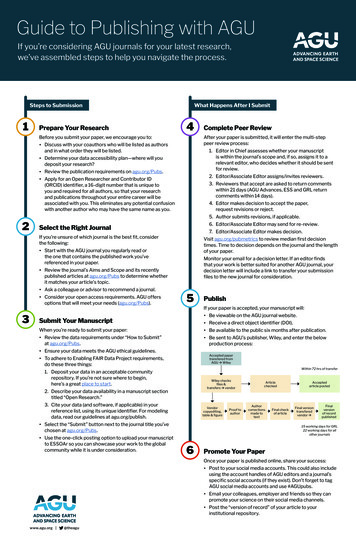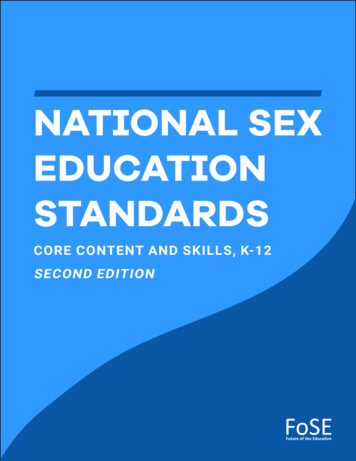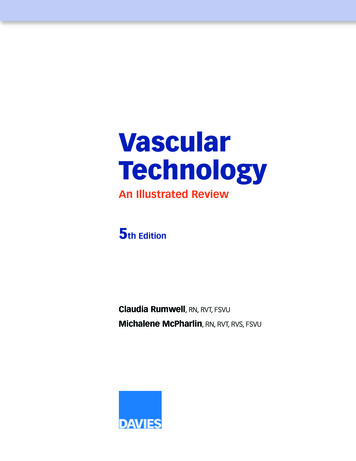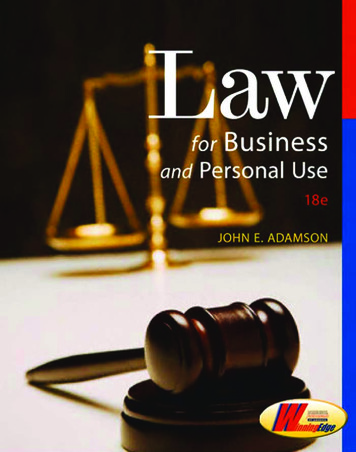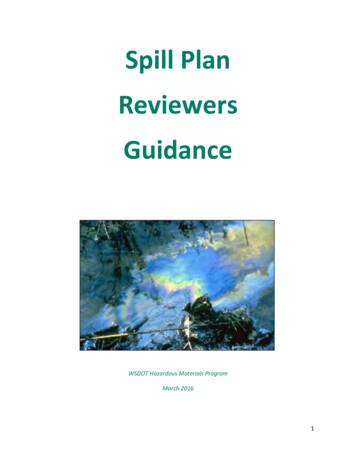
Transcription
Spill PlanReviewersGuidanceWSDOT Hazardous Materials ProgramMarch 20161
2
OverviewPurpose: Spill prevention planning is a key element for protecting the environment during construction.The Spill Plan Reviewer’s Guidance is intended to give WSDOT employees an overview of the elementsof a spill prevention program that is required by contract provisions (Standard Specification 1‑07.15(1))for all WSDOT construction sites.Section 1-2.2J(1) of the Construction Manual requires all WSDOT personnel who review Spill Prevention,Control and Countermeasures (SPCC) plans to take the Spill Plan Reviewer training. The content of thecourse focuses on the overall basics of spill prevention, regulatory reporting requirements and reviewingSPCC Plans to insure compliance with the minimum requirements of the Standard Specification #107.15(1). Hazardous Materials (HazMat) Specialists recommend that Spill Plan Reviewers and ProjectInspectors take this class every two years as a refresher to stay current on changing requirements. Thistraining is available via e-Learning to WSDOT staff through the Learning Management System.When reviewing an SPCC plan, be sure to complete the current Reviewers Protocol form to determinewhether the contractor has prepared a spill plan that satisfies Standard Specification 1‑07.15(1)requirements. If the contractor’s SPCC Plan does not satisfy the requirements, identify the deficientelement(s) on the list provided on the last page of the Reviewer’s Protocol form. For documentationpurposes, attach a completed copy of this form to the SPCC Plan in the project file.Information Sources: Standard Specification #1-07.15(1)HazMat SPCC WebPageo Spill Plan Reviewer’s Guidanceo Spill Plan Reviewers Protocol Checklisti
ii
Table of ContentsOverview . iIntroduction . 11: Responsible Personnel . 32: Spill Reporting . 43: Project and Site Information. 64: Potential Spill Sources. 85: Pre-Existing Contamination . 96: Spill Prevention and Response Training. 117: Spill Prevention . 128: Spill Response . 179: Project Site Map. 1910: Spill Report Forms . 21Hazardous Material Specialist Contact List . 22iii
iv
IntroductionThis document provides supplemental information to accompany the SPCC e-Learning course. Thecontent of this document has been written to be all inclusive as an easy reference for WSDOT staff thathave taken the e-Learning course and need a refresher prior to reviewing a SPCC plan for their project.This guidance document identifies the requirements, information sources, common SPCC plan errors,key notes, and recommendations.1-07.15(1) Spill Prevention, Control, and Countermeasures Plan RequirementsWSDOT Standard Specification 1-07.15(1) and project-specific special provisions (if applicable) require aSpill Prevention, Control and Countermeasures Plan (SPCC Plan or Plan) to be developed for eachWSDOT project. The purpose of an SPCC Plan is to protect human health and the environment fromspills and releases of “hazardous materials,” a generic term used to identify dangerous waste, problemwaste, petroleum products, and hazardous substances.WSDOT Prime Contractor develops the SPCC Plan to satisfy Standard Specification 1-07.15(1) for eachspecific Project.The introduction of this standard specification states the following:“The contractor shall prepare and implement a project-specific spill prevention, control, andcountermeasures plan (SPCC Plan) for the duration of the project. The contractor shall submitthe plan to the Project Engineer no later than the date of the preconstruction conference. Noon-site construction activities may commence until the contracting agency accepts an SPCC Planfor the project.” A SPCC Plan template and guidance information is availableat n.htm.The SPCC Plan shall address all fuels, petroleum products, and hazardous materials, as definedin Chapter 447 of the WSDOT Environmental Procedures Manual M 31-11. Occupational safetyand health requirements that may pertain to SPCC Plan implementation are contained in, butnot limited to, WAC 296-824 and WAC 296-843. The SPCC Plan shall address conditions that maybe required by Section 3406 of the current International Fire Code, or as approved by the localFire Marshal.Implementation RequirementsThe contractor shall update the SPCC Plan throughout project construction so that the writtenplan reflects actual site conditions and practices. The contractor shall update the SPCC Plan atleast annually and maintain a copy of the updated SPCC Plan on the project site. The contractorshall fully implement the SPCC Plan, as accepted and updated, at all times.”1
The SPCC plan must have the following 10 elements in order:1.2.3.4.5.6.7.8.9.10.Responsible PersonnelSpill ReportingProject and Site InformationPotential Spill SourcesPreexisting ContaminationSpill Prevention and Response TrainingSpill PreventionSpill ResponseProject Site MapSpill Report FormsThe remainder of this document is organized according to the SPCC elements listed above.Key Notes and Recommendations: An SPCC Plan is a site-specific, comprehensive plan written and maintained by the contractor toprevent, respond to, and/or report spills/releases of hazardous materials into the environment.Although not required, it recommended that the WSDOT Prime Contractor executive, projectmanager, and superintendent sign the SPCC Plan.WSDOT staff reviewing SPCC plans should have knowledge of the project boundaries, sensitiveareas, type of project work and pre-existing contamination.2
1: Responsible PersonnelStandard Spec Requirements:“Identify the names, titles, and contact information for the personnel responsible for implementing andupdating the plan and for responding to spills.”Additional Information Sources: Construction Project Engineering OfficeCommon Error: Contractors do not list subcontractors who are responsible for spill response in Tables 1.Key Notes and Recommendations: If the contractor plans to use a subcontractor, make sure the subcontractor(s) company name(s)and contact information are also included in Table 1.1.A subcontractor may be called if there is a large fuel spill that the contractor is not equipped tohandle, and/or if there are ignition sources nearby that cannot be shut off. In this case thecontractor may just back off because personal safety is always the most important first step.The contractor does need to mention what actions they will take while waiting for thesubcontractor to respond.3
2: Spill ReportingStandard Spec Requirements:“List the names and telephone numbers of the Federal, State, and Local agencies the contractor shallnotify in the event of a spill.”Additional Information Sources: Ecology Spills Webpage4
Common Errors:Contractor forgets to highlight the appropriate Ecology Regional Office number.Key Notes and Recommendations: The spill plan needs to include the correct Ecology Region. See Ecology Region map below tohelp you verify if the correct region was identified within the spill plan.The contractor should delete the numbers that don’t apply.Ecology Region mapWSDOT Region map5
3: Project and Site InformationStandard Spec Requirements:“Describe the following items:a.b.c.d.The project work.The site location and boundaries.The drainage pathways from the site.Nearby waterways and sensitive areas and their distances from the site.”Information Sources: Contract/ Temporary Erosion and Sediment Control (TESC) planAerial photos/mapsProject Documents: Joint Aquatic Resource Permit Application (JARPA), drawings, and permitconditions.State Route (SR) ViewNotes: Pay close attention to the refueling area, the heavy equipment parking area, and the chemicalstorage areas. Each of these areas may potentially affect sensitive areas, so the contractorshould have adequate spill plans and spill response equipment for each location.The TESC plan or the permit/drawings should list sensitive areas such as streams and wetlands.Aerial photos and topographic maps may help identify drainage pathways. For projects adjacentto sensitive areas, a site visit may be helpful.Permit conditions may require hazardous materials storage a specific distance away fromstreams and wetlands.Common Error and Key Note: Spill Plans often include poorly written project and site descriptions. It should address the entireproject limits and all conducted work.6
Example:Table 3 Nearby Waterways1 and Sensitive Areas21Waterway or2Sensitive AreaDerby CreekMilwaukee DitchDistance fromProject SiteDirection of Flow fromProject SiteRunoff Drainage Pathway fromSite35 feet east ofProject Sitedownhill towards thenortheastdownhill to northeast from theProject staging area to the lowerreach of Derby Creek350 feet south ofProject siteacross the pavement tothe eastacross the pavement east of theroundabout, into the catch basin, andinto Milwaukee DitchNotes:1Waterways include streams, creeks, sloughs, rivers, Puget Sound, etc.2Sensitive areas are areas that typically contain populations that could be particularly sensitive to a hazardous materialsspill or release. Such areas include wetlands, areas that provide habitat for threatened or endangered species, nursinghomes, hospitals, child care centers, etc. Sensitive areas also include areas where groundwater is used for drinking water,such as wellhead protection zones and sole source aquifer recharge areas.7
4: Potential Spill SourcesStandard Spec Requirements:“Describe each of the following for all potentially hazardousmaterials brought or generated on-site (including materialsused for equipment operation, refueling, maintenance, orcleaning):a. Name of material and its intended use.b. Estimated maximum amount on-site at any one time.c. Location(s) (including any equipment used below theordinary high water line) where the material will bestaged, used, and stored and the distance(s) fromnearby waterways and sensitive areas.”Fuel TanksKey Notes and Recommendations: EPA's federal SPCC requirements under 40 CFR 112may apply to facilities that stores more than 1,320gallons of oil products in above ground containers andhas a reasonable possibility of spilling oil to waterbodies. Although WSDOT projects are not subject tothe federal SPCC requirements, WSDOT refers to thisregulation for guidance on preventative measures tostop spills from occurring on projects. If the totalamount in the estimated maximum amount of on-site hazardous materials exceeds 1,320gallons, contact your WSDOT HazMat Specialist to discuss options (see contact list on the lastpage).Talk with the Construction Office or look at the permit drawings to determine if any work will bedone below the ordinary high water line. If it will, the plan must identify the materials that willbe used for operating, refueling, maintaining, and cleaning the equipment that will be used.Example: Items brought on site, such as vehicles and equipment (generators, chain saws, etc.) containinglubricants and fuels, and above ground storage tanks.Hazardous material containers, such as epoxies, glue, solvent, form oil, hardening compounds.Contaminated stockpiled soil that is not properly lined and covered.Generated waste such as bridge paint chips.Unexpected encounters of underground storage tanks or contaminated soil and water.8
5: Pre-Existing ContaminationStandard Spec Requirements:“Describe any preexisting contamination and contaminant sources (such as buried pipes or tanks) in theproject area that are described in the Contract provisions and plans. Identify equipment and workpractices that shall be used to prevent the release of contamination.”Additional Information Sources: Hazardous Materials Discipline ReportsContract documents/TESC PlanGeneral Special Provisions / Special ProvisionsSoil management planWater management planContaminated media management planCommon Errors:The contractor often misses the information provided in Underground storage tank removalthe contract documents and is not aware of pre-existing contamination.Key Notes and Recommendations: The spill plan must describe pre-existing contamination if identified in the contract documents(GSP, Special Provisions, plans). If checking the contract documents, look for a Special Provisiontitled “Removal and Disposal of Hazardous Material.” Such a provision would most likely beunder “Division 2 Earthwork,” then under “Removal of Structures and Obstructions” or“Structure Excavation,” and then under “Construction Requirements.”If no pre-existing contamination or contaminant sources are described in the Contractdocuments, this plan component is “not applicable” or N/A.The SPCC Plan must identify preventative measures to avoid the release or spreading ofcontamination. Other project-specific plans may provide information about pre-existingcontamination and how to properly manage the materials. If you have any questions, contactthe Project Engineer.9
Example:Soil contaminated with petroleum products issuspected near the southeast corner of theintersection of SR 99 and Cordane Street. Ifsoil that is suspected of being contaminated isencountered, it will be stockpiled in thevicinity of the excavation for characterizationsampling and determination of disposaloptions. Soil that is suspected of beingcontaminated will be stockpiled separatelyfrom soil showing no indication ofcontamination. Soil that is suspected of beingcontaminated will be stockpiled on anContaminated ground or surface water collection and treatmentimpervious surface and will be set up to allowin Baker tank.for ease of sampling and load-out oncecharacterization is complete. Stockpiles ofsuspected contaminated soil will be covered with plastic sheeting when not being worked; stormwaterthat could run into the base of such stockpiles will be diverted from the area.10
6: Spill Prevention and Response TrainingStandard Spec Requirements:“Describe how and when all project personnel, includingrefueling personnel and other Subcontractors, shall betrained in spill prevention, containment, and response and inthe location of spill response kits.”Additional Information Sources: WAC 296-824 (Training/Emergency Response)Key Notes and Recommendations: The contractor needs to mention the location of theSPCC plan and the spill kits. They must also mentionwhen spill prevention, containment, and responsetraining will occur. Contractors need to let us know they understand that they must follow L&Iguidelines for emergency response.Spill Plan Reviewers should not interpret L&I requirements for contractors.Common Error:Contract doesn’t identify when and how often personnel (including sub contractors) will be trained.11
7: Spill PreventionSpill Prevention Subsections.Since Spill Prevention has eight required subsections, the format structure is intentionally different forclarity.Additional Information Sources: International Fire Code Section 3406.2NPDES PermitEcology Spill Prevention web pageA. Spill response kit contents and location(s).Standard Spec Requirements:“The contents and locations of spill response kitsthat the Contractor shall supply and maintainthat are appropriately stocked, located in closeproximity to hazardous materials andequipment, and immediately accessible.”Spill Kit contentsKey Notes and Recommendations: Appropriately sized kits need bemaintained in close proximity tohazardous materials and equipment andwill be immediately accessible to allproject employees. Projects with work insensitive areas typically need more spillkits. Projects within or adjacent toSpill pads and sockssensitive areas need to include socks.Suggested and Common Spill Kit items o Personal protective equipment(PPE) - such as safety glasses, gloves, coveralls, boot coverso Spill pads (also called diapers)o Absorbento Large Boomso Mini booms (also called socks)o Catch basin coverso Anti-static shovelso Garbage bagso Plastic sheetingo Over-pack or disposal drumo Complete copy of SPCC Plan!12
Project inspectors should make sure contractor maintains or restocks the spill kits afterincidents.B. Security measures for potential spill sources.Standard Spec Requirements:“Security measures for potential spill sources to prevent accidental spills and vandalism.”Key Notes and Recommendations:The spill plan must describe the securitymeasures that will be maintained to preventvandalism of potential spill sources, e.g., thestaging area will be surrounded by a securedfence, hazardous materials will be stored inside alocked storage shed, equipment will be equippedwith locked fuel caps, etc.Example of a fenced/secured areaC. Material storage and secondary containmentpractices and structures.Standard Spec Requirements:“Methods used to prevent stormwater fromcontacting hazardous materials.”Key Notes and Recommendations:The plan should describe the following:oooSecondary containment methods and/orBermed/covered stockpileBMPsDrip pans or other protective devices willbe used for all hazardous material transfer and cleaning operations; andOil and fuel transfer valves and fittings, fuel hoses, and the like will be stored to preventspills into Waters of the State13
The Hazardous Material Program developed a Secondary Containment focus sheet that providesguidance on the following:1. What is required?2. What needs secondary containment?3. Examples of secondary containment used andmaintenance requirements.4. What encourages compliance?D. Secondary containment practices and structures.Standard Spec Requirements:“Secondary containment for each potential spill sourcelisted in 4, above. Secondary containment structuresshall be in accordance with Section S9.D.9 of Ecology’sConstruction Stormwater General NPDES Permit, wheresecondary containment means placing tanks orcontainers within an impervious structure capable ofcontaining 110 percent of the volume contained in thelargest tank within the containment structure. Doublewalled tanks do not require additional secondarycontainment.”Secondary containment for equipmentDouble walled fuel tanks do not requiresecondary containmentKey Notes and Recommendations:Make sure the contractor describes the methods thatwill be used to prevent stormwater contact withhazardous materials, e.g. contaminated soil will beplaced on bermed plastic and covered.Poor secondary containment example14
E. Best Management Practices (BMP) MethodsStandard Spec Requirements:“BMP methods used to prevent discharges to ground orwater during mixing and transfer of hazar
Jul 05, 2017 · Control and Countermeasures (SPCC) plans to take the Spill Plan Reviewer training. The content of the course focuses on the overall basics of spill prevention, regulatory reporting requirements and reviewing SPCC Plans to insure compliance with the minimu
